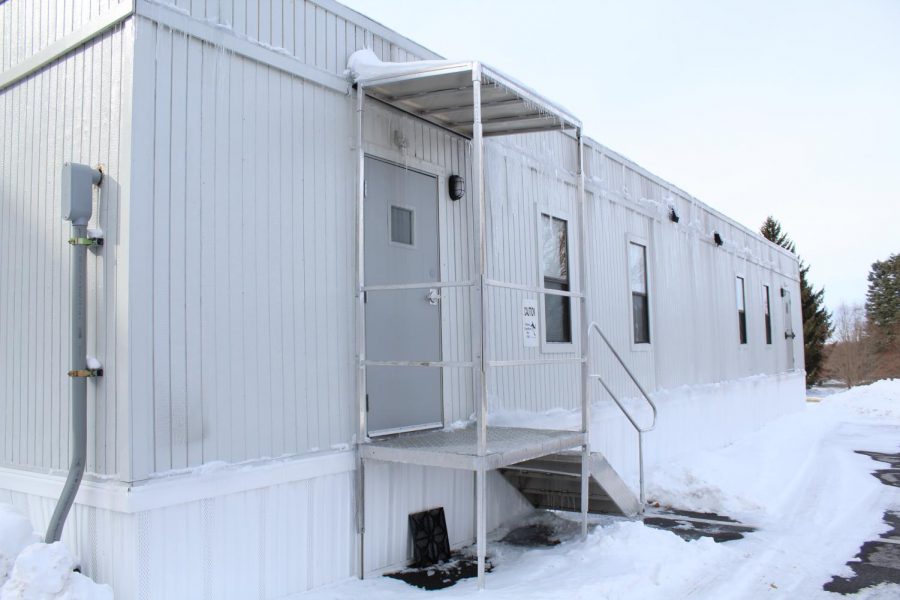Temporary Classroom Modulars Replace Fall’s Tent Classrooms
In the ongoing effort to combat educational disturbances during the COVID-19 pandemic, the Colgate University Task Force on Remote Learning has implemented a series of temporary classroom modulars around campus to be used during the Spring 2021 semester.
The change in season in Hamilton made the previous use of classroom “tents” as temporary learning spaces nonviable. The trailer initiative is aimed at maximizing the number of spring courses that can be taught via in-person instruction, while also abiding by social distancing requirements.
Given the limited classroom space on campus, and the cleaning processes performed by the custodial staff before and after each class period, members of the Colgate Task Force, alongside Classrooms, Media and Events Director Mark Hine and Chief Information Officer Niranjan Davray came up with trailer installation and repurposing of space as a solution. In order to support faculty and students alike, a series of non-traditional learning spaces were converted to classroom use, including the Clark Room, Palace Theater, Thought Into Action and the Starr Rink.
The new trailers constructed around campus ensure a safe space for faculty who are able to teach fully in-person or hybrid courses during popular class times. Each modular holds more than thirty students, set-up with tablet chairs borrowed from other learning spaces, as well as projection and other various technological capabilities. President Casey commended both Associate VP for Facilities and Planning Steve Hughes and Associate Dean of Faculty for Curricular and Academic Affairs Douglas Johnson for their efforts in swiftly organizing and establishing an effective winter solution, noting the “increased flexibility” of the classroom trailers.
When asked about the planning and preparation that made the installation process possible, Johnson addressed the lengths the members of Facilities’ staff went to in order to ensure high standards of learning for both in-person and remote participants.
“ITS has had to fit dozens of classrooms with digital capture and projection equipment, as well as work with CLTR on faculty development opportunities related to technology use and remote instruction,” Johnson said. “Our students and faculty have been phenomenal in terms of dealing with the constraints of COVID-19, but we all also owe an enormous debt of gratitude to the staff on campus who support our ability to teach, learn and grow together.”
The modulars currently serve as classroom settings for a wide range of subjects and departments. Department of Computer Science Chair and Professor Joel Sommers teaches a hybrid section of Intro to Computing I in the 113 Broad Street Module. Sommers said he was greatly appreciative for the opportunity to split his class of 74 students with ten remote participants into two in-person sessions during the week.
“The experience inside is actually quite good, I think, and I’m happy for the larger space that can at least handle half my class,” Sommers said.
Sophomore Jack Maguire, a student in Sommers’ Intro to Computing I, said his experience with the Module has been positive thus far.
“We have a big class so we’re pretty spaced out. When we’re in person I have no trouble hearing him [but] over Zoom, it can be hard to hear. I found no problems being in the trailer. It was warm. It has chargers. It’s like a regular room. I would [prefer it to Zoom]. Definitely,” Maguire said.
Sophomore Peyton Lee is a tutor for the Introduction to Neuroscience class taught in-person by Associate Professor of Psychology and Neuroscience Jun Yoshino in the 113 Module. Although her initial experience had some challenges, her subsequent class experiences echo Maguire’s.
“The first day, there was this air humidifier that was on and it was so loud and we could barely hear Professor Yoshino talk but then the other tutor turned it off and then it was fine. I was by the door for the first class which was open so I was a little bit chilly. I had to keep my jacket on the whole time but now I’ve been there for three classes and it feels pretty normal, like the setting inside feels like a normal classroom,” Lee said.
Junior Elizabeth Casey said that, although it feels like a normal classroom, there are some unique aspects that make it slightly more inaccessible.
“It’s a little darker than a normal classroom and because of the spacing it can be hard to see the screens, they’re pretty big and overall it doesn’t feel super different than a normal classroom,” Casey said.
Professor of the Humanities and Medieval & Renaissance Studies in the Department of English Lynn Staley also teaches a section of CORE 151 Legacies of the Ancient World in the 113 Broad Street Trailer. Staley noted the benefits of having a large space to teach in with heat and electricity, and windows that can open up when the weather gets warm.
“It’s wonderful to be teaching in person, and I’m grateful that Colgate met the needs of faculty and students,” Staley said.
Erin Knox is a senior from Branford, CT concentrating in English with a minor in economics. She has previously served as a staff writer for The Maroon-News....







